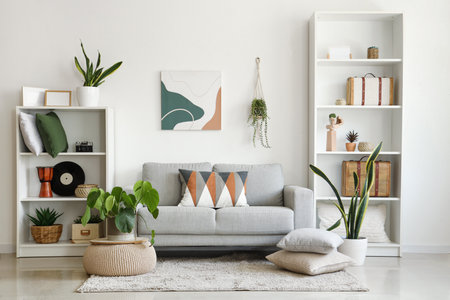Set Your Intention for the Refresh
Before you start moving furniture around, take a moment to identify your goals for rearranging your living room. Are you hoping to create a more inviting space for guests, enhance your relaxation time, or simply give your home a seasonal update? By setting a clear intention, you’ll be able to make mindful choices that reflect your lifestyle and values. Maybe you want to open up the room for family game nights, carve out a cozy reading nook, or make your space feel brighter and airier for summer. Whatever your reasons, having a purpose will guide your decisions and ensure that every change supports the way you actually live. Remember, refreshing your living room isn’t just about aesthetics—it’s about making your home work better for you and everyone who shares it.
2. Evaluate Your Space and Flow
Before you start moving any furniture, take a step back and really assess your living room’s layout. Understanding the natural flow of your space is key to creating a comfortable, functional environment. Think about how people usually enter the room, where they tend to walk, and which areas are most frequently used. Identifying these pathways helps you avoid placing furniture in spots that might disrupt movement or make the space feel cramped.
Consider the Focal Point
Every living room has a focal point—it might be a fireplace, a large window with a great view, or even your TV. Arrange your seating so it naturally faces this feature, making the space more inviting and centered. If your room doesn’t have an obvious focal point, create one with art, a statement chair, or an eco-friendly accent piece.
Natural Light & Entryways
Pay attention to how sunlight fills the room throughout the day. Placing sofas or chairs near windows can make the most of natural light and reduce your need for artificial lighting—an easy win for energy savings. Be mindful not to block entryways or doorways; keeping these areas open enhances both flow and safety.
Quick Assessment Checklist
| Element | What to Look For | Sustainable Tip |
|---|---|---|
| Focal Point | Main feature (fireplace, TV, window) | Highlight with upcycled décor |
| Pathways | Clear walking routes (min. 3 feet wide) | Avoid overcrowding with extra pieces |
| Natural Light | Sunniest spots in the room | Position reading nooks here to save energy |
| Entryways | No blocked doors or access points | Use compact, multi-purpose furniture nearby |
Tip:
If you’re feeling unsure, try sketching out your current layout on paper or using painter’s tape on the floor to visualize new arrangements before making any heavy lifts. This simple step keeps things flexible—and saves your back!

3. Embrace Sustainable and Flexible Solutions
When you’re ready to give your living room a fresh look, consider eco-friendly strategies that are both practical and stylish. Start by reusing and repurposing what you already own. That old side table might make a perfect plant stand, or maybe your bookshelf can double as a room divider to redefine the space. By working with what you have, you not only reduce waste but also keep your refresh budget-friendly.
Look for multi-functional pieces that can adapt to your lifestyle—think ottomans with hidden storage, modular sofas that can be rearranged for movie nights or game days, or nesting tables that tuck away when you need extra floor space. This flexibility allows your living room to easily transform based on different gatherings or moods, whether it’s hosting friends for game night or enjoying a cozy solo evening with a good book.
Embracing these sustainable and versatile approaches isn’t just about style—it’s about making thoughtful choices that help protect the environment while ensuring your living room remains inviting and adaptable for years to come.
4. Play with Focal Points and Conversation Areas
When you’re looking to breathe new life into your living room, shifting your furniture to emphasize focal points and conversation areas is a game changer. In American homes, the living room often serves as both a gathering spot for friends and family and a place to unwind. Whether your focal point is a classic brick fireplace, a panoramic window with backyard views, or an eye-catching piece of wall art, orienting your seating around it can completely refresh the vibe.
Start by identifying what draws attention when you first enter the room. If it’s a fireplace, angle sofas and chairs to face it, creating a warm, inviting nook—perfect for cozy evenings or casual chats. For rooms with stunning outdoor views, let those windows shine by arranging seats to soak in the natural light and scenery. And if you have a statement artwork or gallery wall, consider making that the backdrop for your main seating area.
| Focal Point | Furniture Arrangement Tips |
|---|---|
| Fireplace | Group sofas and armchairs in a semi-circle facing the hearth; add a coffee table for convenience. |
| Picture Window | Place low-back seating facing the window; keep taller pieces off to the side to maximize views. |
| Art Wall | Position couches so that guests naturally face the art; use accent lighting to highlight key pieces. |
If you entertain often, create multiple conversation zones. A pair of accent chairs near a window forms one intimate chat area, while a sectional sofa anchors the main group space. Don’t be afraid to float furniture away from walls—this can actually make your room feel more open and social. Layer in eco-friendly textiles like recycled cotton throws or natural fiber rugs for comfort and sustainability.
The key is flexibility: experiment with layouts until the space feels fresh yet functional. Rearranging not only changes how your living room looks but also how it feels to live in—a simple shift can spark new energy without buying anything new.
5. Layer in Comfort and Personal Touches
Once you’ve established a functional layout, it’s time to bring your living room to life with layers of comfort and personality. Start by adding cozy textiles that invite relaxation—think plush area rugs that anchor your seating arrangement, soft throw blankets draped over sofas or accent chairs, and an assortment of pillows in calming, earthy hues. These elements not only soften the space but also create a welcoming vibe that feels right at home in any American household.
Don’t overlook the power of greenery. Introducing houseplants—whether it’s a statement fiddle leaf fig or a collection of smaller succulents—infuses your living room with natural beauty and helps purify the air. If caring for plants isn’t your thing, high-quality faux options can still add that fresh, nature-inspired touch.
Finally, personalize your space with meaningful décor pieces. Display family photos in sustainably sourced wooden frames, showcase unique finds from local artisans, or incorporate vintage treasures passed down through generations. These personal touches tell your story and transform a simple furniture arrangement into a warm, inviting retreat where everyone feels welcome.
6. Test and Fine-Tune Your Arrangement
Once youve finished rearranging your living room furniture, take a few days to truly live with your new setup. Pay attention to how the space feels as you go about your daily routines. Are you finding it easier to move around? Is there a natural flow for conversations or relaxing with family and friends? Notice any spots where light, airflow, or comfort could be improved. After spending some time in your refreshed space, make small tweaks as needed—maybe shifting a chair closer to a window for more natural light or moving a coffee table to create extra walking space. The goal is to ensure your living room supports not only comfort and connection but also reflects sustainable choices by making the most of what you already have. Personalizing your arrangement helps create a welcoming environment that truly feels like home, all while minimizing waste and embracing mindful design.

